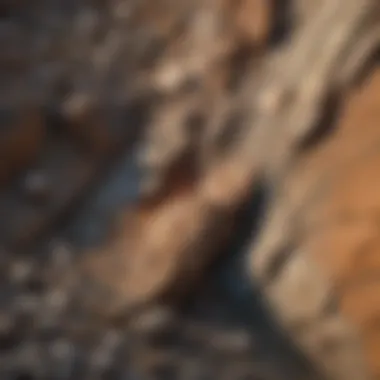Unveiling the Enigmatic Universe of Flat River Stones


Rock and Fossil Identification
Collecting Tips and Techniques
Collecting flat river rocks necessitates adherence to best practices to ensure a successful and fruitful expedition. Locating prime collecting sites along riverbanks demands meticulous observation of geological features such as exposed bedrocks and gravel bars. Once a promising location is identified, collectors must employ safe and ethical methods to extract specimens from the riverbed. Proper techniques like rock flipping with care and using mesh screens to sift through sediments facilitate the collection process while minimizing environmental impact.
Preservation and Display
Preserving the integrity of flat river rocks involves employing techniques that maintain their natural beauty and geological significance. To prevent deterioration, rocks and fossils should be stored in a dry, well-ventilated environment away from direct sunlight and moisture. Utilizing archival-quality materials like acid-free paper and storage boxes helps safeguard the specimens for long-term preservation. For creative display ideas, arranging flat river rocks in shadow boxes, glass containers, or custom-built shelving units showcases their beauty while highlighting the uniqueness of each piece.
Geological Insights
A deeper exploration of flat river rocks unveils fascinating insights into the geological processes that shaped these stones over millennia. Understanding the formations and structures present in these rocks provides valuable clues about the earth's geological history and evolution. Their historical significance as witnesses to ancient landscapes and ecosystems adds a layer of intrigue to their study. Notable discoveries in the field of geology have been fueled by the examination of flat river rocks, offering researchers new perspectives on Earth's past and present environments.
Introduction
Flat river rocks hold a mysterious allure, beckoning us to explore their smooth surfaces and diverse shapes. Within the realm of geology, these humble rocks serve as gateways to ancient wonders, revealing insights into Earth's storied past and the dynamic processes that shaped our planet.
Unveiling the Beauty of Flat River Rocks
The allure of smooth surfaces
Smooth surfaces of flat river rocks captivate collectors and geologists alike. Their tactile appeal evokes a sense of connection to nature, offering a serene and calming presence. These rocks, polished by the river's flow, display a unique luster that reflects the play of light in mesmerizing patterns.
Varied shapes and sizes
Flat river rocks come in an array of shapes and sizes, each telling a story of erosion and deposition. From rounded pebbles to elongated slabs, their diversity adds layers to geological exploration. The varied shapes offer clues to the turbulent journey these rocks have undergone, revealing the forces of nature at work.
A gateway to geological wonders
As gateways to geological wonders, flat river rocks unveil the secrets of the Earth's history. Embedded within their layers are echoes of past environments, preserving a geological timeline for us to decipher. Each rock serves as a chapter in a grand narrative of sedimentary processes and environmental change.
Significance of Flat River Rocks
Geological time capsules
Flat river rocks act as geological time capsules, encapsulating epochs within their mineral confines. Their composition preserves remnants of ancient landscapes, providing glimpses into the distant past. Studying these rocks unlocks the mysteries of geological time, fostering a deeper understanding of Earth's evolution.
Indicators of past environments
By examining flat river rocks, geologists decode the indicators of past environments. Fossil imprints and sedimentary layers tell tales of bygone landscapes, painting vivid pictures of primordial ecosystems. Understanding these indicators grants us insight into the ancient conditions that shaped our world.


Understanding sedimentary processes
Flat river rocks offer a window into sedimentary processes, showcasing the transformative power of water and time. Layers of sediment reveal the gradual buildup of mineral deposits, reflecting the cyclical nature of geological change. Through exploring sedimentary processes, we unravel the intricate mechanisms of rock formation and transformation.
Formation and Characteristics
Flat river rocks, a mesmerizing facet of geological splendor, hold integral significance in the intricate tapestry of Earth's history and formation. Their unique formation and characteristics offer a gateway to unraveling the natural phenomena that have shaped our planet over eons. Understanding the geological journey of these flat rocks unveils a narrative of erosion and transportation, sedimentary deposition, and their transformation into the smooth wonders we admire today. Their diverse colors and textures, ranging from earthy hues to vibrant shades, showcase the kaleidoscope of mineral compositions interwoven with intricate patterns. Exploring the formation and characteristics of flat river rocks opens a portal to a trove of geological insights and revelations.
The Geological Journey
Erosion and Transportation
Erosion and transportation, key mechanisms sculpting flat river rocks, play a pivotal role in their genesis. The ceaseless forces of erosion, spurred by wind and water, sculpt rocky terrains into pebbles and stones. These shards journey through rivers, carried aloft by currents, polishing their surfaces to a smooth sheen. This erosional ballet, akin to a geological waltz, showcases nature's meticulous craftsmanship in refining rough ores to polished gems. Understanding the nuances of erosion and transportation illuminates the patient artistry that crafts each flat rock, drawing a profound connection between geological forces and the treasures they forge.
Sedimentary Deposition
Sedimentary deposition, the tranquil phase following erosion's tempestuous dance, sees these rocks settle in riverbeds or deltas. Layers of sediment gradually blanket these stones, compacting over time under immense pressure to form cohesive rock layers. This sedimentary embrace enfolds the rocks in a cloak of geological history, preserving the story of their origins within intricate strata. Delving into sedimentary deposition unveils the tranquil interlude in the turbulent journey of flat river rocks, where the forces of nature coalesce to immortalize these geological artifacts.
Transformation into Flat Rocks
The final metamorphosis of rough stones into flat river rocks unfolds as sedimentary layers undergo gradual lithification. Immense pressures, coupled with mineral-rich fluids infiltrating the rock matrix, cement particles together, solidifying them into cohesive rocks. Over time, these rocks undergo further erosion, shaping them into flat, smooth forms that grace riverbeds and shores. The transformation into flat rocks symbolizes nature's patient craftsmanship, molding rugged fragments into serene treasures that intrigue and captivate geology enthusiasts. Unraveling the enigmatic process of this metamorphosis illuminates the journeys these rocks undertake, narrating a tale of resilience and transformation in the crucible of Earth's geological crucible.
Exploring Geological Significance
In this section, we delve into the crucial exploration of the geological significance of flat river rocks, unraveling the rich tapestry of knowledge these geological wonders hold. Understanding the geological significance of flat river rocks is paramount in appreciating the intricate processes that have shaped our Earth over millennia. By examining these rocks, we gain insights into ancient environmental conditions, fossil imprints, and geological dating techniques.
Clues to Earth's History
Ancient environmental conditions
The examination of ancient environmental conditions embedded in flat river rocks provides a unique window into Earth's historical landscapes. It offers a glimpse into the climatic conditions, flora, and fauna of bygone eras. By analyzing the sedimentary layers and mineral compositions of these rocks, geologists can reconstruct past environments with remarkable accuracy. The study of ancient environmental conditions is indispensable for piecing together the puzzle of Earth's evolutionary timeline, shedding light on the forces that have sculpted our planet.
Fossil imprints and traces
The discovery of fossil imprints and traces within flat river rocks unveils a treasure trove of biological remnants from ancient epochs. These fossilized imprints offer valuable documentation of prehistoric life forms, enhancing our understanding of past ecosystems and evolutionary processes. By studying these fossils, scientists can infer information about extinct species, their behaviors, and their adaptations to changing environments. Fossil imprints and traces contribute significantly to our knowledge of biodiversity, evolution, and the interconnectedness of life on Earth.
Geological dating techniques
Geological dating techniques applied to flat river rocks play a pivotal role in determining the age and formation timeline of geological strata. Through radiometric dating, stratigraphy, and other dating methods, scientists can ascertain the temporal context of rock formations and associated fossil remains. These techniques enable the precise dating of geological events, offering insights into Earth's dynamic history and the chronology of geological processes. Geological dating empowers researchers to construct accurate timelines of Earth's formation, evolution, and geological events, revolutionizing our understanding of deep time.
Environmental Indicators
The examination of environmental indicators presented by flat river rocks provides valuable clues about past landscapes and geologic events. These indicators offer crucial information about the depositional environments, tectonic activities, climatic fluctuations, and weathering patterns that have shaped Earth's surface. By studying the environmental indicators encapsulated in flat river rocks, scientists can unravel the complex interplay between landforms, natural processes, and environmental changes throughout history.


Riverbed versus coastal formations
Analyzing the distinctive characteristics of riverbed versus coastal formations preserved in flat river rocks highlights the influence of different depositional settings on rock morphology and mineral composition. Riverbed rocks exhibit distinct sedimentary features related to water flow dynamics, erosion patterns, and sediment sources, providing insights into ancient river systems. In contrast, coastal formations reflect processes such as wave action, tidal influences, and shoreline shifts, elucidating past coastal environments and geological phenomena.
Impact of tectonic movements
The impact of tectonic movements recorded in flat river rocks underscores the dynamic nature of Earth's crust and the effects of plate tectonics on rock deformation and uplift. Tectonic imprints, such as folds, faults, and mountain-building events, reveal the tectonic history of a region and the forces that have shaped its topography. By examining these structural features, geologists can infer the tectonic processes responsible for the formation of mountain ranges, basins, and other landforms, unraveling the geological intricacies of plate movements.
Climate and weathering influences
Studying the influence of climate and weathering patterns on flat river rocks provides key insights into the chemical, physical, and biological processes that have altered rocks over time. Climate indicators, such as mineral weathering rates, oxidation states, and sediment textures, reflect past climate conditions and environmental changes. By analyzing these indicators, researchers can reconstruct ancient climates, assess weathering effects on rock surfaces, and interpret the broader environmental context in which these rocks formed. Understanding the impact of climate and weathering on flat river rocks enhances our knowledge of Earth's environmental history and geological transformations.
Practical Applications and Decorative Uses
Flat river rocks offer a multitude of practical applications and decorative uses, making them versatile geological treasures. These rocks play a crucial role in landscaping and design, adding a unique touch to various environments. Their natural beauty and durability make them ideal for both functional and aesthetic purposes. Landscaping enthusiasts and artists alike appreciate the artistic value these rocks bring to their projects.
Landscaping and Design
Garden Pathways and Accents
Flat river rocks are commonly used to create enchanting garden pathways and accents in outdoor spaces. Their smooth surfaces and earthy hues blend seamlessly with organic elements, enhancing the overall appeal of garden landscapes. These rocks provide a natural and visually pleasing pathway for pedestrians while adding texture and depth to garden beds. Their versatility and ease of integration make them a popular choice for garden designers seeking a harmonious connection between nature and artistry.
Aquarium and Terrarium écor
In aquatic and terrestrial habitats, flat river rocks serve as decorative elements in aquariums and terrariums. Their innate beauty and diverse colors enhance the visual aesthetics of these environments, mimicking natural underwater and land formations. Fish, reptiles, and amphibians benefit from the addition of flat river rocks, providing them with shelter and substrate diversity. The varied sizes and textures of these rocks allow for creative landscaping within enclosed habitats, promoting a balanced and naturalistic setting.
Artistic Mosaics and Sculptures
Artists and craftsmen often incorporate flat river rocks into their mosaic designs and sculptures to create stunning visual pieces. These rocks add a layer of intricacy and dimension to artistic creations, offering a unique charm that captivates viewers. The smoothness and unique patterns found in flat river rocks make them ideal for intricate mosaic work, evoking a sense of earthy elegance in both outdoor and indoor art installations. Sculptors leverage the durable nature of these rocks to fashion captivating sculptures that withstand the test of time, illustrating the artistic fusion of nature and craftsmanship.
Functional Purposes
Massage and Reflexology Stones
Flat river rocks find practical application in massage and reflexology practices, providing a natural and therapeutic tool for relieving tension and promoting relaxation. The smooth, contoured surfaces of these rocks make them ideal for massage therapy, as they conform to the body's curves and deliver targeted pressure. Reflexologists use these rocks to stimulate pressure points on the feet, hands, and body, facilitating energy flow and overall well-being. The tactile nature of flat river rocks enhances the sensory experience during massage sessions, creating a holistic approach to healing and wellness.
Ceremonial and Spiritual Practices
In various cultural and spiritual traditions, flat river rocks hold symbolic significance and are used in ceremonial rituals and spiritual practices. These rocks symbolize strength, grounding, and connection to the earth, serving as conduits for energy and intention setting. From meditation gardens to sacred spaces, flat river rocks feature prominently in ceremonial enactments and rites of passage, fostering a sense of reverence and tranquility. Practitioners harness the elemental essence of these rocks to establish spiritual bonds with nature and channel positive energies in their respective practices.
Cultural and Historical Significance
Flat river rocks bear cultural and historical significance in indigenous communities and heritage preservation efforts. These rocks recount tales of ancient rituals, land formations, and historical events, reflecting the rich tapestry of human interaction with the natural world. Ethnographers and archaeologists study the symbolic meanings attached to flat river rocks, unraveling the narratives embedded within their geological structure. Their historical relevance extends to art forms, architecture, and storytelling traditions, underscoring the enduring cultural legacy preserved through the artistic and utilitarian uses of flat river rocks.


Preservation and Ethical Collecting Practices
Preservation and Ethical Collecting Practices play a pivotal role in the conservation of flat river rocks, ensuring their sustainability and protecting the natural environment they are sourced from. By adhering to ethical practices, collectors help maintain the delicate ecological balance of river ecosystems while safeguarding these geological treasures for future generations. Sustainable Collection Methods strive to minimize the environmental impact of rock extraction and promote responsible harvesting techniques.
Sustainable Collection Methods
Respecting Natural Habitats
Respecting natural habitats involves collecting flat river rocks in a manner that respects the surrounding ecosystem. This method emphasizes the importance of preserving the flora and fauna of riverbanks while harvesting rocks. By minimizing disturbances to wildlife and vegetation, collectors can maintain the biodiversity of river ecosystems. Respecting natural habitats is crucial for maintaining the ecological equilibrium of river environments and ensuring the long-term sustainability of flat river rock collection initiatives.
Minimizing Environmental Impact
Minimizing environmental impact is a core principle of sustainable collection methods. This aspect focuses on reducing the ecological footprint of rock extraction activities by employing environmentally friendly practices. By minimizing soil erosion, water contamination, and habitat destruction, collectors can mitigate the negative effects of rock collection on the surrounding environment. This approach aims to preserve the natural beauty of river landscapes and protect the fragile balance of aquatic ecosystems.
Community Conservation Initiatives
Community conservation initiatives involve collaborating with local communities to promote responsible rock collecting practices. By engaging with stakeholders, collectors can raise awareness about the importance of preserving flat river rocks and their natural habitats. These initiatives encourage community involvement in conservation efforts, fostering a sense of ownership and stewardship among residents. By working together, collectors and communities can protect valuable geological resources and promote sustainable harvesting practices.
Legal Considerations
Protected Areas and Regulations
Protected areas and regulations provide essential guidelines for the ethical collection of flat river rocks. These measures aim to designate specific zones where rock harvesting is permitted while safeguarding environmentally sensitive areas from exploitation. By adhering to protected area regulations, collectors can ensure that their activities do not disrupt fragile ecosystems or violate conservation laws. This framework helps preserve the natural beauty of river landscapes and promotes sustainable practices in rock collection.
Ethical Sourcing and Trade
Ethical sourcing and trade practices prioritize transparency, fairness, and sustainability in the rock collecting industry. This approach involves sourcing flat river rocks from reputable suppliers who adhere to ethical standards and promote responsible extraction methods. By supporting ethical sourcing and trade, collectors contribute to the conservation of geological resources and ensure the welfare of local communities involved in the rock trade. This ethical framework promotes accountability and integrity in the rock collecting sector, fostering trust and credibility among consumers and stakeholders.
Supporting Local Economies
Supporting local economies is a key initiative in ethical rock collecting practices. By purchasing flat river rocks from local suppliers and artisans, collectors can stimulate economic development in communities where rock resources are abundant. This practice helps generate income opportunities for residents and encourages sustainable livelihoods based on rock-related activities. By supporting local economies, collectors contribute to the socio-economic growth of regions dependent on rock trade, fostering economic resilience and cultural preservation.
Conclusion
In delving into the realm of flat river rocks, it becomes abundantly clear that these geological treasures are not merely stones but windows to Earth's history and natural beauty. The significance of exploring flat river rocks lies in unraveling the geological implications they offer, from portraying ancient environmental conditions to aiding in understanding sedimentary processes. By studying and appreciating flat river rocks, individuals can gain a deeper connection to the planet's past and enrich their understanding of geological phenomena.
Embracing the World of Flat River Rocks
A testament to Earth's beauty
Embarking on a journey to understand flat river rocks reveals an awe-inspiring testament to Earth's intricate processes. The allure of their smooth surfaces and varied shapes speaks volumes about the geological forces that shaped them over centuries. In this article, highlighting the beauty of flat river rocks emphasizes their role as natural storytellers, showcasing the artistry of nature's handiwork in crafting these unique stones.
Continued exploration and discovery
Continued exploration and discovery of flat river rocks open doors to endless possibilities in unraveling Earth's mysteries. The key lies in the relentless quest for knowledge, as each new find potentially uncovers hidden gems of information about our planet's past. This article encourages readers to engage in the ongoing pursuit of geological understanding through exploring the secrets embedded within flat river rocks, perpetuating a cycle of curiosity and discovery.
Inspiring a passion for geology
At the heart of studying flat river rocks lies the potential to ignite a fervent passion for geology. These rocks serve as tangible evidence of Earth's evolution, sparking a deep-seated fascination with the planet's intricate history. By inspiring a passion for geology, this article aims to cultivate a community of enthusiasts dedicated to delving into the wonders of the natural world, fostering a sense of wonder and appreciation for the complexities that lie beneath the surface.







